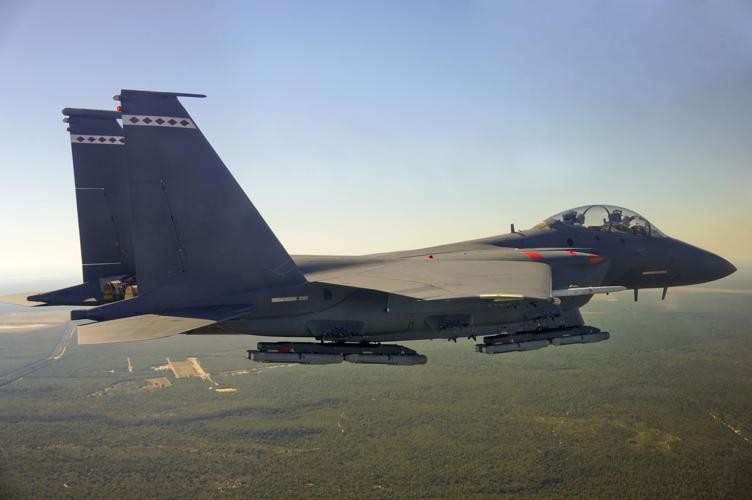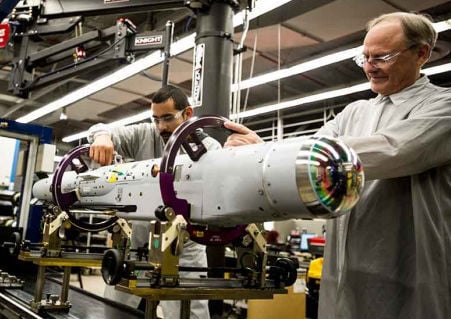After more than a decade of development and a year behind schedule, a small, all-weather guided glide bomb made by Tucson-based Raytheon Missiles & Defense has been approved for initial deployment on the Air Force’s F-15E Strike Eagle.
The approval for Raytheon’s GBU-53/B Small Diameter Bomb II, dubbed StormBreaker, means that F-15E squadrons can now be equipped with the weapon and deployed for missions, Raytheon said.
The roughly 6-foot-long unpowered bomb features pop-out wings and can glide through adverse weather conditions to hit moving targets more than 45 miles away with a 105-pound warhead.
Under an Air Force-led joint program with the Navy, the StormBreaker will also be fitted aboard the Navy’s F/A-18 Hornet and the F-35 Lightning II joint strike fighter.
A fielding decision for the F/A-18 is expected later this year; deployment aboard the F-35 isn’t expected until the new fighter gets additional software in 2022.
The GBU-53/B Small Diameter Bomb II is a follow-on to Boeing’s Small Diameter Bomb, a similar glide bomb that lacks the ability to hit moving targets.
After a controversial competition with Boeing for the SDB II, Raytheon won a development contract worth up to $450 million in 2010 and was awarded an initial, low-rate production contract in 2015.
StormBreaker features a multimode seeker that can guide the weapon through any dust or adverse weather with imaging infrared, millimeter-wave radar, and semi-active laser guidance, in addition to or with GPS and inertial navigation system guidance.
“The weapon gives airmen a significant advantage — the ability to strike maritime or land-based maneuvering targets at range in adverse weather,” said Cristy Stagg, StormBreaker program director at Raytheon Missiles & Defense, adding that the weapon “has proven itself in many complex test scenarios.”
The Air Force plans to spend about $2 billion on development of the StormBreaker and $3.2 billion to procure more than 17,000 copies of the weapon, according to the Government Accountability Office.
The development path hasn’t been easy for StormBreaker, which was planned for initial operating capability in August 2019.
Hardware and software problems delayed the program, while unit costs grew significantly, according to a Government Accountability Office report issued in June.
During operational testing in 2018 and 2019, the program completed 56 mission scenarios and reported 11 failures, the GAO found.
StormBreaker production was partially halted in 2019 after several safety deficiencies were discovered, including faulty safety clips that could allow the bomb’s guidance fins to inadvertently deploy before launch, the agency said.
Raytheon is planning to retrofit all 598 delivered weapons with a redesigned component, at the company’s cost, the GAO said.
The SBD II program started with a scandal that rocked the defense community.
Boeing won the original competition in 2003 but the project was on hold for several years due to a corruption scandal involving Darleen Druyun, a former top Pentagon acquisition executive.
Druyun served a nine-month federal prison term in 2005 after admitting in 2004 she had acted to favor Boeing in contracts for the SDB II and a new Air Force tanker, in expectation of taking an executive post with the aerospace giant.
UACI GETS GLOBAL DESIGNATION
The University of Arizona Center for Innovation has earned a special designation as a “Soft Landing” site for foreign companies looking to enter the U.S. market.
The school said the designation from the International Business Innovation Association (InBIA) reflects the tech-oriented business incubator’s longstanding reputation as an entrepreneurship center capable of offering the kind of help international businesses need to succeed in America.
InBIA, based in Orlando, Florida, is a global nonprofit network with a mission of helping entrepreneurs succeed across borders.
The UACI won the InBIA Soft Landing designation after an extensive, peer-reviewed application process, the UA said.
Last fall, the UACI was one of 10 sites nationwide for the U.S. Department of State’s Global Innovation through Science and Technology Initiative, hosting a cohort of international small-business executives and providing access to potential customers, networking, mentoring and entrepreneurial skills training.
The incubator launched its first international business-assistance program, Global Advantage, in 2004, with a strategy to attract foreign companies by working with technology business incubators in other countries.
In 2014, the UA revamped the program to focus on identifying and recruiting companies that are eager to partner with the school in six technology areas.
5 WIN UA TECH TRANSFER AWARDS
The global pandemic has moved many events online, including the Tech Launch Arizona’s seventh annual I-Squared Expo and Awards, honoring the movers and shakers of UA technology commercialization.
TLA, the UA’s technology commercialization arm, has created a dedicated website featuring award details, videos and expo pages for exhibitors.
This year’s award winners are:
- Inventor of the Year — Jim Schwiegerling of the UA College of Optical Sciences;
- Startup of the Year — Neuro-ID;
- Campus Collaboration Award — Carol Stewart, UA associate vice president for Tech Parks Arizona;
- David N. Allen Award for Leadership & Vision — UAVenture Capital co-founder Fletcher McCusker;
- Student Inventor of the Year — Vinodh Subramanian.
The I-Squared Ecosystem Impact Award went to a group of Tech Launch Arizona’s commercialization partners, 32 volunteer experts who are part of a larger network of more than 1,600 volunteer experts — including many UA alumni — who help TLA vet new technologies and guide entrepreneurs.





